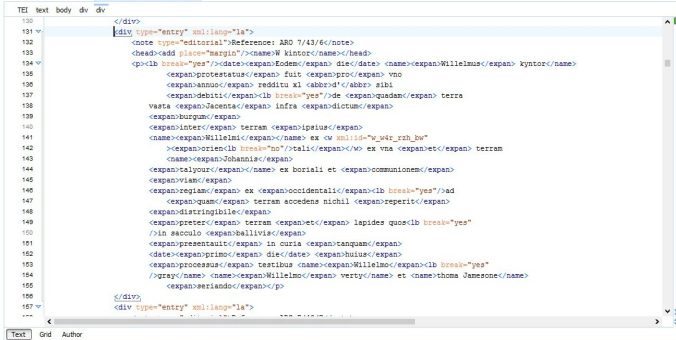Law in the Aberdeen Council Registers 1398-1511: Concepts, Practices, Geographies
Aberdeen’s fifteenth-century town council registers illuminate the workings of this Scottish burgh in a way unsurpassed by other Scottish urban records of the era. They also demonstrate the interconnections of people and ideas across northern Europe in the age of the renaissance. The task of our project is to unlock the text of these important records, the first eight volumes of which were inscribed on the UNESCO UK Memory of the World Register in 2013.
The Aberdeen council registers are primarily legal records, containing court proceedings, ordinances, elections, dispositions of property, and correspondence. The surviving registers from 1398 to 1511 miss only one volume (c.1415–c.1433). They are hand-written, mostly in Latin and Middle Scots. Our study reaches to the end of volume 8 (covering 1501–1511).

Our team is drawn from the fields of Law, History, Computational Linguistics, Historical Socio-Linguistics, and Archives. This multidimensional expertise generates an important set of dialogues which inform our approach to this digital humanities project housed by the Research Institute of Irish and Scottish Studies (RIISS) and funded by the Leverhulme Trust, RIISS and Aberdeen City Council. Building on a strong partnership with the Aberdeen City & Aberdeenshire Archives, and a track record of two pilot projects, one funded by RIISS and one by the RCUK Digital Economy Hub, we have built the capacity for a new contribution to a range of subject areas.
Ours is not a conventional digitisation project: high-quality images already exist. Neither are we producing a database. Our goal is to create a digital textual resource from the registers, which is as open as possible to future analysis. To do this we are undertaking a transcription and TEI-compliant mark-up of the entire corpus of text from the registers covering 1398–1511. Working with both the images and the original register volumes, and using the open-source HisTEI framework, our research team produced a durable electronic resource. The particular challenge is to move from heavily abbreviated handwritten script which appears on the original pages, to an accurate TEI representation of textual meaning and structure. This enrichment will make the corpus digitally open and importable into a wide range of software tools. It will also make it available for comparative study in different fields.


This digital resource forms the basis for our academic programme. Here we are motivated to examine change in the law itself and in its use over time. How did legal concepts expressed in the registers alter, or remain constant, in relation to social developments, and within a European context? And how were concepts shaped by practices: how was the law applied, who used particular concepts, when and to what ends? The linguistic shift in the registers from Latin to Middle Scots over time opens a potentially instructive window onto these issues.
Our questions also concern the jurisdictional frameworks in which the Aberdeen courts functioned. We are investigating what they were and how the town interacted with other jurisdictions. Such frameworks might encompass other towns, corporate or sovereign powers, as well as roles and capacities of private individuals. Other jurisdictions include the Scottish courts of the sheriff, the church, other towns, and at a national level the conciliar session, or the king himself. Our common interest is to understand the registers as records of law, capturing a shared European heritage of legal discourse, in its urban, rural and maritime complexities.
For the future, we aim to develop opportunities for new explorations. We are mindful of the wider context in which to understand the Aberdeen registers corpus, looking comparatively at similar records in northern Europe, looking ahead in time (encompassing issues across the long period 1400–1800), and looking for related archival collections in Aberdeen and elsewhere in Scotland. We wish to set the basis now for future computing-led analysis of the corpus through conceptual annotations, and to enable new development of searching and user interface tools. Finally, we believe that these records are tremendously exciting artefacts in their own right, and that new audiences deserve to learn about them. To that end the public dissemination of our questions, and the most interesting answers we find, is an important aspiration.